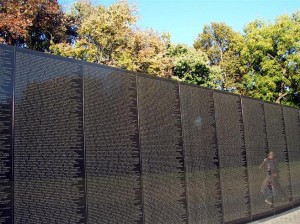I’d like to begin by thanking you all for a wonderful semester; I’ve learned so much from you all. I especially enjoyed reading this week’s blog posts and listening to Thursday’s discussion. Many of you argued that slavery must be acknowledged and even underscored when remembering the Confederacy. Although I’m sure you’re all quite busy with your final projects, I think taking a moment to consider Thursday’s prompt more concretely is worthwhile. If a memorial could be constructed that allowed white southerners to honor their ancestors without insulting black southerners, what would such a memorial look like?
Victor and Juri suggest that statues of great men might be a way for white southerners to honor soldierly courage without emphasizing slavery. But might this approach still offend black southerners? Does placing a monument to a black “hero” – such as the Arthur Ashe monument on Richmond’s Monument Avenue – alongside monuments to Confederate “heroes” solve the problem?
Contrastingly, Courtney suggests:
Perhaps the time for Confederate memorials in the classical sense, of imposing statues or even street names, is past. But this, conveniently, fits in with growing trends in America which value the glorification of communal heroes less and less.
If “hero” monuments are not as compelling to today’s citizens, what should a modern Confederate monument look like? Maybe some of you have seen the Vietnam Veterans Memorial Wall in Washington, D.C., which is inscribed with the names of American veterans killed or missing in action.
What does this monument communicate about the Vietnam War? Why might a memorial like this be more compelling to some citizens today, and why might it be controversial or offensive to others? Could a memorial like this allow white southerners to honor their ancestors without insulting black southerners? Could slavery’s role in the Confederate cause be forthrightly acknowledged in a monument like this?
Perhaps constructing “living monuments” would allow for a more complex and complete acknowledgement of slavery in remembrances of the Confederacy than material monuments. Responding to Horwitz’s account of the trivia contests utilized by Confederate heritage organizations, Alex offers this thought:
Heritage societies need to recognize the violently oppressive actions of their “Confederate Heroes.” Instead of quizzing followers as to “how many horses did Nathan Bedford Forrest have shot from under him during SCV trivia night, a more appropriate trivia question should be “which terrorist organization did Forrest lead to violently oppress black liberty following emancipation?”
If you made a trivia quiz about Dick Dowling, what questions would you choose to include? Do you see your final projects as constructing “living memorials” to Dowling?
Again, thank you all for your thought-provoking blog posts and discussions this semester. I’m looking forward to your final projects!


